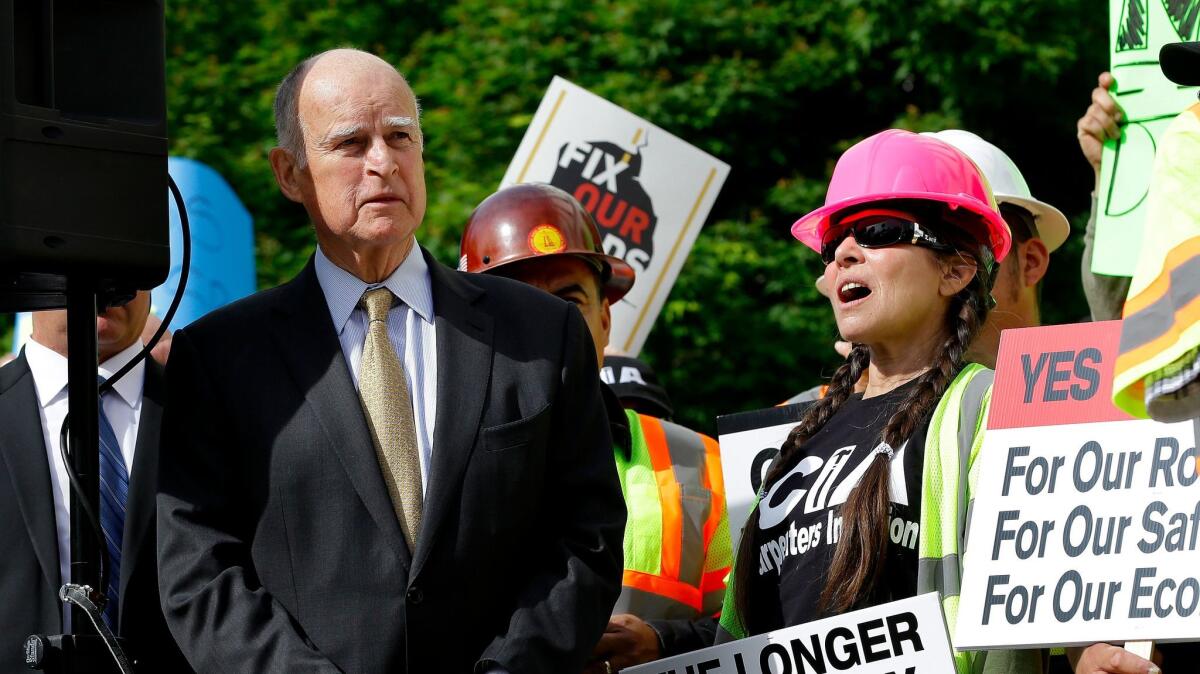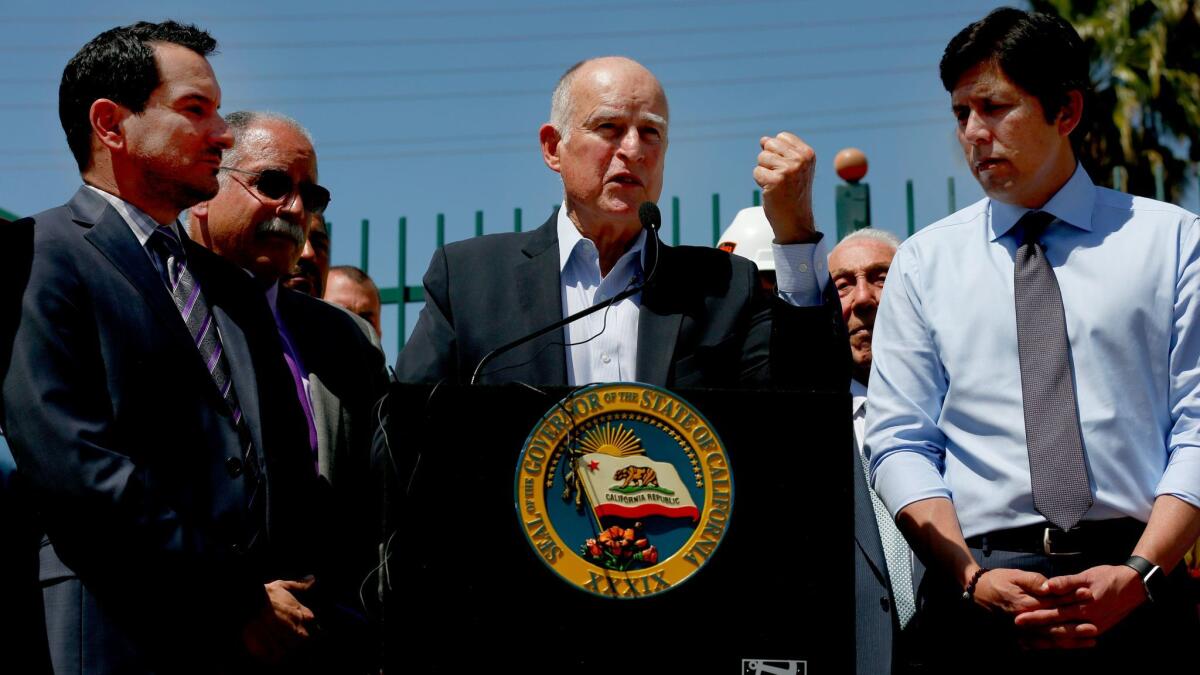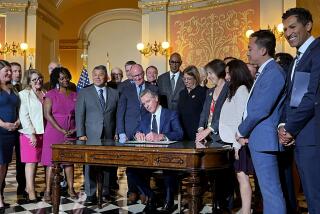That $52-billion road bill just made California’s next climate change move a heavy lift

Reporting from Sacramento — It took late-night cajoling and nearly $1 billion in deal sweeteners for Gov. Jerry Brown and top Democrats to muscle through a $52-billion tax-and-fee plan just over a week ago to repair California’s roads.
Now they have to do it all again. Brown and legislative leaders have another daunting battle ahead over the fate of the cap-and-trade program, the centerpiece of California’s efforts to combat climate change.
The program requires companies to buy permits to release greenhouse gases into the atmosphere, and just like the road plan, it’s expected to require a two-thirds vote. That’s a tall order, even for Democrats who hold supermajorities in both chambers; the transportation legislation squeaked through without a vote to spare.
The looming question in the Capitol, said California Chamber of Commerce President Allan Zaremberg, is, “How many two-thirds votes is the Legislature capable of doing?”
Facing legal uncertainty over whether cap and trade can continue past 2020, Brown has urged lawmakers to act quickly to reauthorize the program. But the lingering hangover of a hard-fought battle to pass the road repair bill may make consensus on a controversial climate program harder to reach.
“I think it is going to make the whole thing much harder,” said Amy Vanderwarker, co-director of the California Environmental Justice Alliance.
Complicating the issue will be the potential impact on gas prices. The transportation package included a 12-cent hike in the base excise tax on gasoline. Extending the cap-and-trade program could mean an additional gasoline price increase of between 24 and 73 cents a gallon by 2031, according to the nonpartisan Legislative Analyst’s Office.
Here’s what you should know about this year’s debate over California’s cap-and-trade program »
The program’s supporters dispute that any specific cost increase can be attributed to cap and trade. But politicians are keenly aware that their votes can be weaponized by their opponents and depicted as a source of more pain at the pump.
“A lot of my families in the district do have to drive long distances to work,” Assemblywoman Sabrina Cervantes (D-Riverside) said, adding that “it’s hard for my district to get access to clean vehicles” that require less gas.
She acknowledged that climate change is an “existential threat,” but said she’s uncommitted on cap and trade right now. Cervantes was one of the last Democrats to back the road bill April 6, signing on only after negotiating $427 million in additional transportation projects in her county.
Dangling money to woo reluctant lawmakers is a time-honored tactic in the Capitol, and political veterans predict there could be a feeding frenzy over cap-and-trade money. The program has produced billions of dollars from the sale of pollution permits.
The vote “gets slightly tougher because of the wheeling and dealing with transportation tax,” said Steven Maviglio, a Democratic strategist who worked on the transportation bill, which has yet to be signed by Brown.
On climate, Maviglio forecast that “there will probably be an auction for a vote.”
There are some political factors working in cap and trade’s favor. Unlike the gas tax, which consistently draws stiff opposition in polls, California’s climate programs typically score highly among the state’s residents. A Public Policy Institute of California survey last year found that a majority supported the cap-and-trade program.
There’s also potential for bipartisan support. One Assembly Republican, Catharine Baker of the east Bay Area city of Dublin, supported setting tougher targets for reducing greenhouse gas emissions last year. In addition, extending the cap-and-trade program would continue an existing policy, which could be less politically poisonous than a new tax.

“This is an opportunity for many people to show that they can make programs that are already on the books better,” Zaremberg said.
But climate policy tends to trigger bruising Capitol battles, especially in recent years. A measure to increase the state’s reliance on renewable electricity and make buildings more energy-efficient passed in 2015 only after a controversial provision to slash oil consumption for transportation was dropped.
In that case, the legislation required only a majority vote. For cap and trade, supporters are aiming for two-thirds. The push for the higher threshold is the result of complicated rules governing — some critics would say strangling — California’s budget process.
The law that provides the foundation for cap and trade was passed by a majority vote in 2006. The Chamber of Commerce charged that the program functioned as a tax on businesses, making it unconstitutional because it wasn’t approved with the two-thirds vote required by Proposition 13, California’s landmark tax law approved by voters in 1978.
A state appeals court recently rejected their argument, handing a victory to environmentalists and the Brown administration.
But there’s another hurdle from a 2010 ballot initiative, Proposition 26. Under those rules, regulatory fees also require a two-thirds vote, a standard that could apply to extending cap and trade.
“In order to remove that legal uncertainty, a two-thirds vote would be required,” said Ross Brown of the nonpartisan Legislative Analyst’s Office.
The governor, who has staked his legacy on fighting climate change and is counting on cap-and-trade revenue to help finance the bullet train from Los Angeles to San Francisco, wants the higher threshold.
“To remove any cloud of perceived legal uncertainty about the continuation of cap-and-trade beyond 2020, we are seeking a two-thirds vote,” Deborah Hoffman, a spokeswoman for the governor, said in a statement.
As the effort to cobble a supermajority takes off, so does a ferocious lobbying battle.
Oil companies kept a low profile during the debate over the gas tax, saving their clout for the climate issue. The industry backs cap and trade, particularly in comparison with stricter proposals to reach the state’s emissions targets.
Catherine Reheis-Boyd, president of the Western States Petroleum Assn., said in a statement that her group is “committed to making significant improvements to cap-and-trade.”
The state’s victory in appeals court this month reduced the industry’s leverage. Still, the potential that lawmakers will be skittish to take back-to-back votes affecting gas prices could help oil companies rally support for a more business-friendly policy.
The environmental lobby, meanwhile, is split between national organizations that want to continue cap and trade and environmental justice groups that are concerned the program isn’t doing enough to alleviate local pollution.
Those groups felt particularly burned by the transportation deal, which gave the trucking industry a break on future antipollution regulations.
“Are all the trade-offs going to be constantly at the expense of environmental justice?” said Assemblywoman Cristina Garcia (D-Bell Gardens), who is working on climate legislation.
Brown asked for the issue of cap and trade to be resolved as part of the state budget in June. But the difficulty of threading the needle has led some advocates to say it shouldn’t be rushed.
“We don’t need it this year,” said Parin Shah, senior strategist at the Asian Pacific Environmental Network. “If we’re able to get it, that would be great. It’s one more thing we don’t need to worry about.”
Others say a hard vote only becomes more difficult with time.
“If we don’t do it now, are we going to do it in an election year?” state Sen. Bob Wieckowski (D-Fremont) said. “It’s a much tougher vote in May 2018.”
The governor holds one other potential advantage in negotiations. He could launch a climate-focused ballot initiative next year, the last year of his final term, and bypass legislators altogether. Brown has $15 million left over from previous campaigns.
Going directly to the voters offers no guaranteed victory. Rob Lapsley, president of the California Business Roundtable, which represents the state’s largest corporations, said the campaign could prompt a surge of oil industry money.
“They wouldn’t hesitate to spend what it takes to defeat it,” he said.
Ultimately, the fate of cap and trade may come down to Brown’s knack for eking out big wins on his priorities.
“The governor bats last. That gives him enormous leverage,” Maviglio said. “Whether it comes to influencing the votes of legislators or putting something on the ballot, he — despite his lame duck status — still is king of the hill when it comes to this issue.”
[email protected]; [email protected]
Follow @melmason and @chrismegerian on Twitter for the latest on California politics.
How will California battle climate change? A new proposal revs up debate over cap-and-trade program
More to Read
Get the L.A. Times Politics newsletter
Deeply reported insights into legislation, politics and policy from Sacramento, Washington and beyond. In your inbox three times per week.
You may occasionally receive promotional content from the Los Angeles Times.












